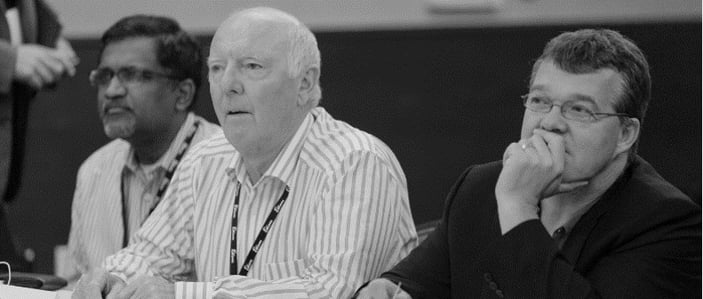As we discussed in part one, building a great culture doesn’t just happen. It requires a leader who wills it into existence and helps set its ideals and principals. Effective leadership is a key ingredient to forging a culture. USGA's Chief People Officer, Steve Shloss, who spoke at the CEO Summit, calls this “Impactful Leadership.” He believes there are 4 main dimensions to an impactful leader, all of which are important to position the leader as the inspiration and steward for a company’s culture.
Steve asked the room full of CEOs, "Who thinks they are a great leader?" Surprisingly, not everyone's hand shot up all at once. Maybe it was modesty; maybe the question was too broad. He then broke it down into the four types:

1. Conscious Leadership
This describes the inward focused elements of leadership. Leaders who are strong in this dimension are:
- In tune with their own strengths and weaknesses
- Seek out help in areas where they need it
- Have high EQ, not just IQ
- Are able to harness their emotions for positive impact and restrain them to avoid negative ones
They are also adaptive and flexible and not dogmatic about forcing every situation into a single decision-making process. They drive their actions from their values (which should be expressed in the culture) and are internally consistent with themselves about what they think and what they do.
Self-Awareness, Emotional Intelligence, Agility, and Values-Driven are some of the keywords that would be associated with this dimension of leadership.
2. Informed Leadership
Steve uses this term to encapsulate the critical thinking and analytical abilities exhibited by leaders.
Strong leaders here have a firm grasp of the drivers that impact their organizations and how they effect decision making. They also integrate the situation the company is in (high growth, struggling, turnaround, etc) as a key input into their decisions.
While keeping a firm eye on the present, informed leaders also strive to gain new knowledge and engage in continual learning to stay ahead of what is changing in their industry and ecosystem. The best leaders in this category demonstrate a deep curiosity – both about how their industry works, as well as how their own organization works. This curiosity is not rooted in check-ups (i.e., pop quizzes of employees to test their knowledge), but more a continual desire to better understand how everything in their world works and how it can be improved.

3. Connected Leadership
Connected refers to the communication and inter-personal skills of leaders.
Those who excel in this dimension are able to build real relationships with those that matter to their organization, both internally and externally. While many pay lip service to concepts like trust, candor, and empathy, impactful leaders integrate these concepts into their leadership style and code of ethics.
These leaders also know how to match the message to the right medium, and know when and how to supplement face-to-face interaction with other forms of communication. These leaders embrace diversity and welcome different backgrounds and points of view, and in turn get a more complete, holistic view of their domain.
This type of leadership embraces debate as a positive tool that is constructive and ultimately leads to better outcomes.
4. Influential Leadership
The last dimension of leadership addresses the ability to work through others to achieve goals.
This is where culture is a key enabler – as it drives home the alignment of everyone in an organization, without the need for an unwieldly command and control infrastructure. This is also where personal charisma and passion shine through for a leader, as a way to inspire those in their organization to work toward a common goal while leaving personal agendas aside.
The key measure of success here however, is the quality of people in an organization. A leader’s ability to not only attract great talent, but also mentor and coach those already there to greater capabilities will ultimately drive the quality and intensity of the culture in an organization.
 Leaders don’t need to excel in every one of these dimensions, but do need to have a baseline level of strength across all. Steve’s final point about leadership and culture is that while it starts from the top, it’s also not a one-person show as the CEO. These attributes should be reflected in leaders at all levels in the organization. Leaders of all stripes have inputs into the ultimate culture of an organization, and the higher the quality of leaders that build the culture, the better the result!
Leaders don’t need to excel in every one of these dimensions, but do need to have a baseline level of strength across all. Steve’s final point about leadership and culture is that while it starts from the top, it’s also not a one-person show as the CEO. These attributes should be reflected in leaders at all levels in the organization. Leaders of all stripes have inputs into the ultimate culture of an organization, and the higher the quality of leaders that build the culture, the better the result!
Are you a great leader? Leave us a comment and tell us why.

